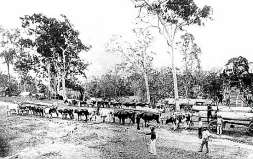Timber
The Pine River, first known variously as the Deception, Blind or Eden River, was eventually named after the Hoop Pine (Araucaria cunninghamii) which was found to be prevalent along its banks. The region's timber industry, which had commenced with the visit of Oxley and Cunningham in 1824, slowly gained impetus during the time of the Moreton Bay convict settlement. During the brief period when the settlement was located at Redcliffe, parties were sent to the Pine Rivers area in search of softwoods. Edmund Lockyer, who visited the settlement in 1825 not long after it had been moved to the present site of Brisbane, commented that "from what is known of the Brisbane, the Blind [Pine] River and the Pumice Stone, they abound with the finest timber that has hitherto been found in New South Wales". He also noted that "several ships in this last year have been principally loaded with it on their home voyage".
After the establishment of free settlement in the 1840s, the timber industry gathered further momentum. Evidence suggests that the Griffin and Joyner families, who held most of the area now occupied by the Pine Rivers Shire as squatting runs obtained through pasturage licences, commenced exploiting the local timber resources as soon as they took up their runs. Although their activities have escaped close historical scrutiny, it is also evident that sawyers and timber-getters were active thoughout the region from the late 1840s. In 1847, two sawyers working on the Griffin's Whiteside run were murdered by Aborigines. In the same year, the Selina, the first sailing vessel built in Brisbane, loaded cedar logs at the Pine River then sank en route to Sydney. Tragically, all lives were lost, but the valuable cargo was later recovered.

Although the first timber-getters were attracted to the valuable softwoods such as Hoop Pine, beech and cedar, hardwoods later became sought after for building infrastructure such as railways, wharves and bridges. Teams of up to twenty bullocks were yoked to a timber jinker to transport logs. Where the terrain allowed, these teams continued into Brisbane, but in the northern and western areas, logs were taken to rafting grounds on the North and South Pine Rivers. The logs were then loaded onto punts or lashed together and towed by steamers out of the Pine estuary, past Sandgate and up the Brisbane River to the sawmills. The Hoop Pine constituted three quarters of all timber used in Brisbane buildings during the mid to late nineteenth century. Vast quantities of timber, especially cedar logs, were also rafted to Dunwich, on Stradbroke Island, for export to overseas ports via Sydney. During later periods, sawmills operated at various locations thoughout the Pine Rivers region.
The timber industry flourished during the 1860s when closer settlement became associated with the building of homesteads (initially slab huts with shingle roofs), stockyards and miles of post and rail fences. As no restrictions were placed on the cutting of timber on freehold land, the clearing of land for agriculture provided vast quantities of logs. Early settlers also supplemented their incomes by procuring timber from Crown land. Prior to 1864, licences had been issued which permitted holders to access any vacant Crown lands and take their choice of timber, but this system created ill-feeling amongst the timber-getters as some would go to considerable trouble to construct tracks into forest areas only to have others come after them and take advantage of the tracks to cut timber in the same vicinity. After 1864, a more restrictive system involving special timber licences came into operation.
In the early 1890s, the Dohle family, who had established a boat building business at Breakfast Creek, began exploiting timber from the area now known as Dohles Rocks. Some years later, in 1902, they purchased land in the area, commenced farming and established a sawmill and boat building enterprise on the banks of the North Pine River using timber cut from their land. The Dohles ingeniously developed a method of cutting timber using a saw driven by a wooden windmill. The Spurwing, a champion sailing boat built by the family, later towed barges laden with timber used in the construction of the original Hornibrook Bridge. This bridge, which linked Brisbane with Redcliffe by spanning the Pine estuary, was built of timber from the Mount Mee and Mount Glorious areas.
